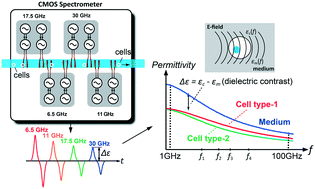Our official English website, www.x-mol.net, welcomes your
feedback! (Note: you will need to create a separate account there.)
A high-throughput flow cytometry-on-a-CMOS platform for single-cell dielectric spectroscopy at microwave frequencies†
Lab on a Chip ( IF 6.1 ) Pub Date : 2018-05-30 00:00:00 , DOI: 10.1039/c8lc00299a Jun-Chau Chien 1, 2, 3, 4 , Ali Ameri 1, 2, 3, 4 , Erh-Chia Yeh 2, 3, 4, 5 , Alison N. Killilea 2, 3, 4, 6 , Mekhail Anwar 1, 2, 3, 4, 7 , Ali M. Niknejad 1, 2, 3, 4
Lab on a Chip ( IF 6.1 ) Pub Date : 2018-05-30 00:00:00 , DOI: 10.1039/c8lc00299a Jun-Chau Chien 1, 2, 3, 4 , Ali Ameri 1, 2, 3, 4 , Erh-Chia Yeh 2, 3, 4, 5 , Alison N. Killilea 2, 3, 4, 6 , Mekhail Anwar 1, 2, 3, 4, 7 , Ali M. Niknejad 1, 2, 3, 4
Affiliation

|
This work presents a microfluidics-integrated label-free flow cytometry-on-a-CMOS platform for the characterization of the cytoplasm dielectric properties at microwave frequencies. Compared with MHz impedance cytometers, operating at GHz frequencies offers direct intracellular permittivity probing due to electric fields penetrating through the cellular membrane. To overcome the detection challenges at high frequencies, the spectrometer employs on-chip oscillator-based sensors, which embeds simultaneous frequency generation, electrode excitation, and signal detection capabilities. By employing an injection-locking phase-detection technique, the spectrometer offers state-of-the-art sensitivity, achieving a less than 1 aFrms capacitance detection limit (or 5 ppm in frequency-shift) at a 100 kHz noise filtering bandwidth, enabling high throughput (>1k cells per s), with a measured cellular SNR of more than 28 dB. With CMOS/microfluidics co-design, we distribute four sensing channels at 6.5, 11, 17.5, and 30 GHz in an arrayed format whereas the frequencies are selected to center around the water relaxation frequency at 18 GHz. An issue in the integration of CMOS and microfluidics due to size mismatch is also addressed through introducing a cost-efficient epoxy-molding technique. With 3-D hydrodynamic focusing microfluidics, we perform characterization on four different cell lines including two breast cell lines (MCF-10A and MDA-MB-231) and two leukocyte cell lines (K-562 and THP-1). After normalizing the higher frequency signals to the 6.5 GHz ones, the size-independent dielectric opacity shows a differentiable distribution at 17.5 GHz between normal (0.905 ± 0.160, mean ± std.) and highly metastatic (1.033 ± 0.107) breast cells with p ≪ 0.001.
中文翻译:

用于微波频率下单细胞介电谱的高通量CMOS流式细胞术平台†
这项工作提出了一个微流体集成的无标记流式细胞术-a-CMOS平台,用于表征微波频率下的细胞质介电特性。与MHz阻抗细胞仪相比,由于电场穿透细胞膜,因此在GHz频率下工作可提供直接的细胞内介电常数探测。为了克服高频下的检测挑战,该光谱仪采用了基于片上振荡器的传感器,该传感器内置了同步频率生成,电极激励和信号检测功能。通过采用注入锁定相位检测技术,该光谱仪提供了最先进的灵敏度,实现了小于1 aF rms的均方根值100 kHz噪声过滤带宽时的电容检测极限(或频移中的5 ppm),可实现高吞吐量(> 1k个单元/秒),并且测得的蜂窝SNR超过28 dB。通过CMOS /微流体协同设计,我们以阵列格式分布6.5、11、17.5和30 GHz的四个传感通道,而选择的频率以18 GHz的水弛豫频率为中心。由于尺寸不匹配而导致的CMOS与微流体集成的问题也通过引入一种经济高效的环氧成型技术得以解决。使用3-D流体动力聚焦微流体,我们可以对四种不同的细胞系进行表征,包括两种乳腺癌细胞系(MCF-10A和MDA-MB-231)和两种白细胞系(K-562和THP-1)。将较高频率的信号归一化为6.5 GHz后,p «0.001。
更新日期:2018-05-30
中文翻译:

用于微波频率下单细胞介电谱的高通量CMOS流式细胞术平台†
这项工作提出了一个微流体集成的无标记流式细胞术-a-CMOS平台,用于表征微波频率下的细胞质介电特性。与MHz阻抗细胞仪相比,由于电场穿透细胞膜,因此在GHz频率下工作可提供直接的细胞内介电常数探测。为了克服高频下的检测挑战,该光谱仪采用了基于片上振荡器的传感器,该传感器内置了同步频率生成,电极激励和信号检测功能。通过采用注入锁定相位检测技术,该光谱仪提供了最先进的灵敏度,实现了小于1 aF rms的均方根值100 kHz噪声过滤带宽时的电容检测极限(或频移中的5 ppm),可实现高吞吐量(> 1k个单元/秒),并且测得的蜂窝SNR超过28 dB。通过CMOS /微流体协同设计,我们以阵列格式分布6.5、11、17.5和30 GHz的四个传感通道,而选择的频率以18 GHz的水弛豫频率为中心。由于尺寸不匹配而导致的CMOS与微流体集成的问题也通过引入一种经济高效的环氧成型技术得以解决。使用3-D流体动力聚焦微流体,我们可以对四种不同的细胞系进行表征,包括两种乳腺癌细胞系(MCF-10A和MDA-MB-231)和两种白细胞系(K-562和THP-1)。将较高频率的信号归一化为6.5 GHz后,p «0.001。











































 京公网安备 11010802027423号
京公网安备 11010802027423号